|
|
|
|
Lesson 3 |
Medicine in the 13-16th centuries: Universities, Hospitals, Anatomical Revolution |
|
|
|
|
|
|
|
As explained above, medicine made a late entrance into the universities becoming a teaching subject only in the late 13th century. It was thanks to the work of Taddeo degli Alderotti (1223-1303) that medicine was fully accepted at Bologna. Other universities followed. The second in Italy was Padua (students from Bologna moved to Padua), then came Naples, Siena, Rome, Pisa, Pavia, Turin and so on. Other universities were established in Europe: Paris, Montpellier, Oxford, Cambridge, Salamanca, Coimbra, Heidelberg, Prague, and Vienna. In Sardinia the University of Sassari was founded in 1616, and that of Cagliari in 1634. Another institution to be founded in mediaeval times was the hospital. The first hospitals grew out of hospices for needy people more than from places for cures. Only in female wards could animals (chickens) be kept. The hygienic conditions were quite basic, to say the least. For example, the bed sheets were never changed, (the slide shows two patients in the same bed and monks preparing coffins in the same room). Pictures of the Lord could not be absent as the hospitals were considered to be places in which the healing presence of the Holy Spirit must exist.
The medical profession began to perform dissections again in the 13th century. However, there was a period in which this ceased from about 1299 when Pope Boniface VIII (who sold Sardinia to Catalonia) issued a Papal Bull entitled "De sepolturis"which forbade manipulation of corpses and the reduction of them to bones. This had two principal aims: 1) stop the dismemberment of cadavers; 2) stop the commerce that had developed in bones from soldiers killed in the Holy land. The Bull was not meant to impede dissection but in practice did stop it. A few years later, dissection once again began thanks to later Popes who understood the mistake which had been made and who issued Bulls allowing dissection in specific periods of the year (above all dissection of women in Lent as they, at the time, were thought to be bereft of their soul, and only later on men). As seen from illustrations, the Professor who wore a long robe that almost concealed his shoes (in order to show his cultural status), was sitting reading a textbook by Galen whereas the surgeon, who was the one who performed the dissection, wore a short gown (the legs could be seen which showed his inferior rank). We know that the findings of the surgeon were by no means taken as real. For instance, because, the humerus demonstrated by the surgeon was straight, and therefore not the same as that described by Galen (who did describe a curved humerus from a pig), the professor stated that it was one of nature's jokes to make the bones seems straight when in reality they were curved. Galen's assertions were a dogma which could not be criticised, because he, and not nature, was the true authority.
In fact, those who truly practised human anatomy were the artists. Some of the artists gave up their salaries in order to avail themselves of corpses from the bishops (Leonardo, Michelangelo, and many others). Above all, Leonardo da Vinci (1452-1519) was the finest of anatomists. He made numerous discoveries that were faithfully reproduced in the manuscripts which remained more or less secret until one of Leonardo's students sold them to the English Royal family, and so today are referred to as the Windsor manuscripts. However, this did not influence anatomy at all. In truth, Leonardo wanted to make an atlas by working together with the anatomist Marco Antonio della Torre, but the latter died very young. Furthermore, also Michelangelo Buonarroti (1475-1564) wanted to make an atlas of anatomy together with Realdo Colombo, but this came to nothing as well.
The Catholic religion did not deter dissections, because the body is only a vessel which contains the soul. In fact pulvis eris, pulvis reverteris. (you were dust, and to dust you will revert). There were great anatomists who began practising anatomy by themselves, without the intervention of a servant surgeon: for example Berengario da Carpi (1460-1530), and Giambattista Canani (1515-1579).
1543 is a year to remember in the history of man, because two of the most important scientific myths of the era were refuted: the ANTHROPOCENTRIC conception and the GEOCENTRIC concept.
In certain respects, the story of Vesalius is obscure. Shortly after the publication of this book (he was 29 years old) he stopped teaching. According to him this was caused by the criticism of the Galenists (which were ferocious), but, in fact, it seems there may have been another motive. He had a tempting offer from Emperor Charles V to become his personal physician. Vesalius accepted, but after a while thought of returning to Padua because the Venetian Senate called him back. Unfortunately, he had an accident: he performed a dissection on a man who resulted not to be dead (his protector, Charles V had died and his successor, Philip II, was not very fond of him). An inquisition followed, and Vesalius was prosecuted, but managed to obtain a pardon by promising to make a pilgrimage to Palestine. So he went to Palestine with a letter from the Venetian Senate requiring him to return to Padua, but he died, probably of plague, on the return journey when the ship moored at the island of Zante. He was buried on Zante, but the whereabouts of his grave is not known (1564). He was one of the greatest geniuses in human history because he shattered the great Galenic dogma, and confirmed anatomy as a science founded on direct observation. Anatomists following Vesalio were: Realdo Colombo (1510-1559), Gabriele Fallopia (1523-1562), and Fabricius (Girolamo Fabrici di Acquapendente 1533-1619), Casserius (Giulio Casserio 1552-1616) is also worthy of mention because he was an uneducated servant to Fabricius who studied Latin and Greek and became a professor. He was the founder of comparative anatomy (he made, inter alia, a very important contribution to the study of the larynx). Another great anatomist was Bartolomeo Eustachi (1500/1510-1574) who operated in Rome: he produced a series of anatomical tables almost surpassing those of Vesalius, at least from a scientific point of view. The tables, engraved in copper, were forgotten until the beginning of the 18th century when Giovanni Maria Lancisi (1654-1720) discovered and published them. Despite the delay in publication, they managed to influence science: it contained details that Vesalius had omitted.
In Medieval times Surgery was mostly carried out by the monks. Following the pronouncements issued from the Council of Tours (1163) and the 4th Lateran (1215), the monks had to give up medicine and surgery, so it was carried out by ordinary unlearned people. In Umbria, near Norcia and Preci, the abbey of St. Eutitius was an important centre of surgical culture. When they had to stop doing surgery the monks instructed the peasants who lived there. Among other things, Norcia was already well-known for its ancient tradition of castrating animals (so there were already people had some practical surgical experience). The people of Norcia and the people of nearby Preci became very skilled craftsmen and handed down the secrets of surgery from father to son. The people of Preci became famous above all for curing the eyes (the Scacchis, who were for years the eye doctors of the French Royal family, became very wealthy and famous). The people of Norcia carried out very advanced plastic surgery, operated on cataracts, and on hemorrhoids and even performed extraction of calculus (stones). They also castrated male children to have unbroken voices for religious choirs, because women were not allowed to sing in churches in the Middle Ages. Minor surgery (dental extractions, healing wounds, etc.) was carried out by licensed barbers: their sign today still is the pole with the red (for the blood) and white (for the bandages) spiral stripes.
|
|
|
From the notes by Rita Piana |
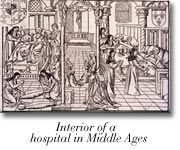 The doors of Mediaeval hospitals were positioned toward the Vatican so that the Holy Spirit was more likely to enter the hospital (this continued until recent times, and is the case in the old Hospital of San Giovanni di Dio in Cagliari). They were built with a chapel that could be seen from all of the hospital's wards. The first hospital in mainland Italy was that of Santo Spirito (Holy Spirit) in Rome, the second was that of St. Maria Novella in Florence which was built from funds donated by Folco Portinari, the father of Beatrice, the woman loved by Dante Alighieri.
The doors of Mediaeval hospitals were positioned toward the Vatican so that the Holy Spirit was more likely to enter the hospital (this continued until recent times, and is the case in the old Hospital of San Giovanni di Dio in Cagliari). They were built with a chapel that could be seen from all of the hospital's wards. The first hospital in mainland Italy was that of Santo Spirito (Holy Spirit) in Rome, the second was that of St. Maria Novella in Florence which was built from funds donated by Folco Portinari, the father of Beatrice, the woman loved by Dante Alighieri. 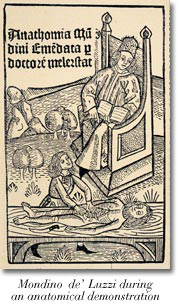 The surgeons did not have access to anatomical knowledge because they did not know Latin, and could not read the textbooks; this was the reason why anatomy became a type of philosophical exercise. The first official dissection was performed at the University of Bologna by Mondino de' Liucci (1270- 1326), a pupil of Taddeo. Although dissection was indirect, being a sort of comment on Galen's texts, Mondino was the most important precursor of modern human anatomy. There were other human anatomists, such as Guido da Vigevano who suspended the corpses so as to be able to dissect them.
The surgeons did not have access to anatomical knowledge because they did not know Latin, and could not read the textbooks; this was the reason why anatomy became a type of philosophical exercise. The first official dissection was performed at the University of Bologna by Mondino de' Liucci (1270- 1326), a pupil of Taddeo. Although dissection was indirect, being a sort of comment on Galen's texts, Mondino was the most important precursor of modern human anatomy. There were other human anatomists, such as Guido da Vigevano who suspended the corpses so as to be able to dissect them. 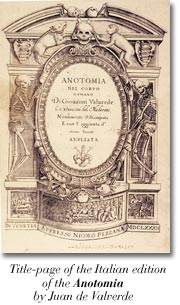 In order to understand how long the practice of dissecting animals continued, the title page of one of the few books on anatomy in Italian (dated 1632 and translated from the textbook written in Spanish by Juan de Valverde, and which can be found at Central Biomedical Libray of Cagliari University) shows a cranium flanked by a pig and a short-tailed monkey: the animals on which Galen's anatomy was mainly based.
In order to understand how long the practice of dissecting animals continued, the title page of one of the few books on anatomy in Italian (dated 1632 and translated from the textbook written in Spanish by Juan de Valverde, and which can be found at Central Biomedical Libray of Cagliari University) shows a cranium flanked by a pig and a short-tailed monkey: the animals on which Galen's anatomy was mainly based.  In addition to the anatomical studies by artists, there were also those who discussed the whole of Hippocratic-Galen theory: Paracelsus (1493-1541) medical philosopher . He is considered to be the founder of iatrochemistry but in reality he was an alchemist since he placed great emphasis on the chemical elements. The chemical elements that he considered to be the basis of the universe were salt, sulphur, and mercury (all things considered, something of the conception of elements was present). He practised alchemy, saying that the basis of disease was an alteration in these elements. He was the first to use ether, and he noted that it had anaesthetic qualities (this practice declined and was rediscovered in America 300 years later). He also used laudanum to alleviate pain and other chemical compounds such as antimony. His physiology remained, above all, confused, even if it certainly contrasted with Galen's physiology.
In addition to the anatomical studies by artists, there were also those who discussed the whole of Hippocratic-Galen theory: Paracelsus (1493-1541) medical philosopher . He is considered to be the founder of iatrochemistry but in reality he was an alchemist since he placed great emphasis on the chemical elements. The chemical elements that he considered to be the basis of the universe were salt, sulphur, and mercury (all things considered, something of the conception of elements was present). He practised alchemy, saying that the basis of disease was an alteration in these elements. He was the first to use ether, and he noted that it had anaesthetic qualities (this practice declined and was rediscovered in America 300 years later). He also used laudanum to alleviate pain and other chemical compounds such as antimony. His physiology remained, above all, confused, even if it certainly contrasted with Galen's physiology. 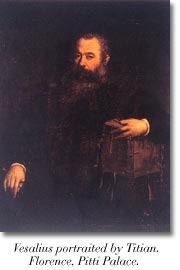 But the great development of anatomy took place thanks to Andreas Vesalius (1514-1564) (son of Emperor Charles V's pharmacist). After having attended famous universities such as Louvain and Paris, and after having received a classical Galenic education, he became professor of anatomy at Padua while he was still very young. In 1543 he published his monumental work "De Humani Corporis Fabrica" in which he describes the human body viewed in dissections performed by himself and illustrated by magnificent woodcuts. Dissection became autopsy in the Hellenistic sense, something which was physically seen by the eyes of the operator himself (note the proud affirmation of the Renaissance man who said: I report only the things which I have seen myself). The frontspiece shows the anatomist (Vesalius himself) operating directly on the corpse of a woman. This picture was the work of the painter who served Vesalius in drawing the illustrations in the book, namely, Jan Stephen van Calcar, a student of Titian. Calcar's plates are very precise portrayals of the dissected parts of the human body: both by themselves and with imagined landscape. The plates were in black and white because colour printing was not in use at the time. Vesalius corrected Galen on 250 points. However, he did not attack the Galenic conception of blood flow even if he demolished it by demonstrating that pores did not exist in the heart, and nor existed a rete mirabile, but that was all he had to say on the subject. In the same year Nicholas Copernicus' book "De Revolutionibus Orbium Celestium" was published, the book which refuted the geocentric theory of the earth.
But the great development of anatomy took place thanks to Andreas Vesalius (1514-1564) (son of Emperor Charles V's pharmacist). After having attended famous universities such as Louvain and Paris, and after having received a classical Galenic education, he became professor of anatomy at Padua while he was still very young. In 1543 he published his monumental work "De Humani Corporis Fabrica" in which he describes the human body viewed in dissections performed by himself and illustrated by magnificent woodcuts. Dissection became autopsy in the Hellenistic sense, something which was physically seen by the eyes of the operator himself (note the proud affirmation of the Renaissance man who said: I report only the things which I have seen myself). The frontspiece shows the anatomist (Vesalius himself) operating directly on the corpse of a woman. This picture was the work of the painter who served Vesalius in drawing the illustrations in the book, namely, Jan Stephen van Calcar, a student of Titian. Calcar's plates are very precise portrayals of the dissected parts of the human body: both by themselves and with imagined landscape. The plates were in black and white because colour printing was not in use at the time. Vesalius corrected Galen on 250 points. However, he did not attack the Galenic conception of blood flow even if he demolished it by demonstrating that pores did not exist in the heart, and nor existed a rete mirabile, but that was all he had to say on the subject. In the same year Nicholas Copernicus' book "De Revolutionibus Orbium Celestium" was published, the book which refuted the geocentric theory of the earth. 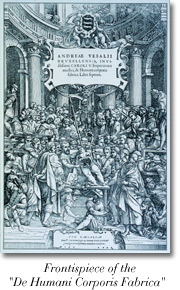 The Paduan School became the most important. The students there were separated according to their nationality and Latin was the official language. From the beginning in Padua the degree was not conferred by the Bishop (as in all other universities), but, rather, it was conferred by the Mayor. This fact was significant because for several years after the Reformation, whereas in the case of the other Catholic universities, Protestants no longer attended because they had to swear allegiance to the Catholic faith, in Padua they did come, at least until the Republic of Venice managed to politically oppose the influence of the papacy. The religious intolerance caused by the Reformation was one of the reasons for the decline of the Italian universities.
The Paduan School became the most important. The students there were separated according to their nationality and Latin was the official language. From the beginning in Padua the degree was not conferred by the Bishop (as in all other universities), but, rather, it was conferred by the Mayor. This fact was significant because for several years after the Reformation, whereas in the case of the other Catholic universities, Protestants no longer attended because they had to swear allegiance to the Catholic faith, in Padua they did come, at least until the Republic of Venice managed to politically oppose the influence of the papacy. The religious intolerance caused by the Reformation was one of the reasons for the decline of the Italian universities.  Fabricius ab Aquapendente (1533-1619) was a great surgeon and professor at Padua from 1565 to 1616. He published numerous surgical treatises and was the teacher of William Harvey, the discoverer of blood's circulation. He built the world's first stable anatomical theatre in Padua. The theatre was circular, the students stood, and the dissection table was in the centre so that all had a precise view of the corpse lying on it. Beneath the table there was an aperture communicating with a canal, which served to take away waste and bring the corpse into the theatre. Until then, the theatres had been mobile. From then public anatomical dissections became social events. Fabricius also merits another distinction: the idea of producing an atlas in colours was his. He entrusted this job to skilled painters of his time, and, at his death willed more than 200 plates to the Marciana library of Venice, where they remained unknown until 1910, when Giuseppe Sterzi (who has been Professor of Anatomy in the University of Cagliari) discovered them.
Fabricius ab Aquapendente (1533-1619) was a great surgeon and professor at Padua from 1565 to 1616. He published numerous surgical treatises and was the teacher of William Harvey, the discoverer of blood's circulation. He built the world's first stable anatomical theatre in Padua. The theatre was circular, the students stood, and the dissection table was in the centre so that all had a precise view of the corpse lying on it. Beneath the table there was an aperture communicating with a canal, which served to take away waste and bring the corpse into the theatre. Until then, the theatres had been mobile. From then public anatomical dissections became social events. Fabricius also merits another distinction: the idea of producing an atlas in colours was his. He entrusted this job to skilled painters of his time, and, at his death willed more than 200 plates to the Marciana library of Venice, where they remained unknown until 1910, when Giuseppe Sterzi (who has been Professor of Anatomy in the University of Cagliari) discovered them. 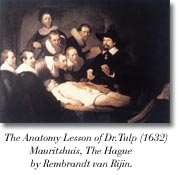 The most celebrated painting of an anatomical dissection ever to exist is that of Rembrandt, preserved in the museum at The Hague. Artistically it is one of the best paintings in the world: Nicolas Tulp 1593-1674) , (who had studied at Padua, is seen showing a dissection to his colleagues. However, from an anatomical point of view, it is a disaster. This demonstrates how anatomy became a kind of still life. The first Italian anatomies are representations of butchery. Among the most famous painters of the subject there was Bartolomeo Passarotti of the Bolognese school who was author (50 years before Rembrandt) of an anatomy showing the dissection of a corpse in the presence of the most famous Italian artists.
The most celebrated painting of an anatomical dissection ever to exist is that of Rembrandt, preserved in the museum at The Hague. Artistically it is one of the best paintings in the world: Nicolas Tulp 1593-1674) , (who had studied at Padua, is seen showing a dissection to his colleagues. However, from an anatomical point of view, it is a disaster. This demonstrates how anatomy became a kind of still life. The first Italian anatomies are representations of butchery. Among the most famous painters of the subject there was Bartolomeo Passarotti of the Bolognese school who was author (50 years before Rembrandt) of an anatomy showing the dissection of a corpse in the presence of the most famous Italian artists. 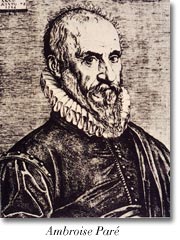 Of the development of anatomy the few doctors who practised did take advantage, but this remained the privilege of an elite. There were famous surgeons (this happened especially in France) who studied anatomy. Ambroise Paré (1510-1590) created the confraternity of the saints Cosmas and Damian, distanced from that of the barbers (they were not as yet true doctors because they did not know Latin, as officially recognised). They operated in France from 1550 onwards. Parč, who became the surgeon of the king, is also remembered because he gave instructions not to use boiling oil on amputations. In one of his treatises he recounts that while he followed a campaign in Piedmont, and had no more boiling oil to put on an amputated leg (it was believed that the boiling oil served to extract the materia peccans), a man from Norcia (Norcino), on the basis of what had been published by Bartolomeo Maggi (1477-1552), advised him to use rose oil (which contains phenol, a mild disinfectant) and to his great surprise noted that the patients treated with rose oil did better than those treated with boiling oil. He placed great importance on anatomy and dissection as a basis for surgery.
Of the development of anatomy the few doctors who practised did take advantage, but this remained the privilege of an elite. There were famous surgeons (this happened especially in France) who studied anatomy. Ambroise Paré (1510-1590) created the confraternity of the saints Cosmas and Damian, distanced from that of the barbers (they were not as yet true doctors because they did not know Latin, as officially recognised). They operated in France from 1550 onwards. Parč, who became the surgeon of the king, is also remembered because he gave instructions not to use boiling oil on amputations. In one of his treatises he recounts that while he followed a campaign in Piedmont, and had no more boiling oil to put on an amputated leg (it was believed that the boiling oil served to extract the materia peccans), a man from Norcia (Norcino), on the basis of what had been published by Bartolomeo Maggi (1477-1552), advised him to use rose oil (which contains phenol, a mild disinfectant) and to his great surprise noted that the patients treated with rose oil did better than those treated with boiling oil. He placed great importance on anatomy and dissection as a basis for surgery.